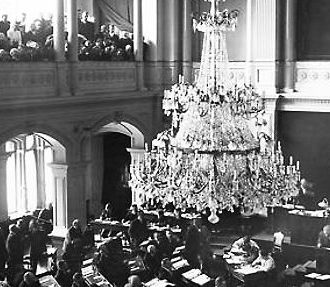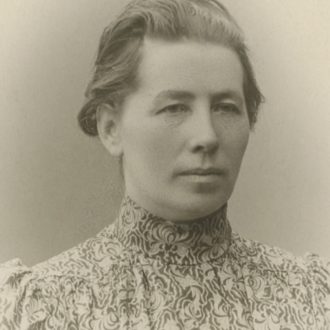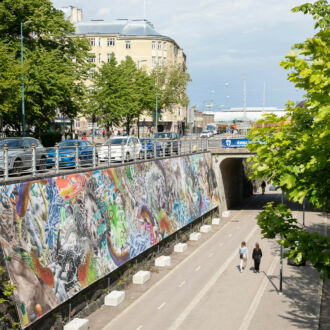In 1906 Finland’s national assembly, Eduskunta in Finnish, became the first parliament in the world to adopt full gender equality. It earned that distinction by granting equally to all men and women the right not only to vote but also to stand for election.
The Finnish Parliament celebrated its centenary in 2006 and 2007. Why did the anniversary cover two different years? Universal and equal suffrage was enacted in Finland in 1906, and the first elections for the new unicameral Parliament were held in 1907.
At that time Finland was still an autonomous Grand Duchy of the Russian empire, but it became independent ten years later, in 1917. Since that time the country has lived through two world wars and the Cold War, and become a member of the European Union.
The duties of the organs of state and their division of power have changed, but the system of parliamentary representation stretching back more than 110 years has proved its durability throughout all these periods. Parliament embodies the Finnish democratic ideal.
Parliamentary reform brought about a major upheaval in political life. For the first time, the right to vote was extended to include all of the country’s adult citizens, irrespective of gender, class, wealth or position. The number of people entitled to vote increased ten-fold. The previous legislative assembly, the Diet, had represented only 15 percent of the male population, and women had had no political rights whatsoever. Finland was the first country in Europe to allow universal and equal suffrage. All adult women were eligible to stand as candidates in national elections in Finland, the first in the world.
The powers of the state in Finland are vested in the people, who are represented by Parliament. Parliament enacts Finnish law, decides on matters such as the state budget and approves international treaties.
The parliamentary system still broadly functions along the principles adopted 110 years ago, although there have been changes in the way candidates are nominated, in legislative periods and in voting methods and procedures.
Women and men from across the country
Parliament contains 200 seats, and parliamentary elections affecting all 200 seats are held every four years; 2019 is an election year.
The Finnish President, who is the head of state, is elected every six years, local councils every four years and members of the European Parliament every five years. This means that there may be elections nearly every year in Finland (for example: local council elections in 2017, presidential elections in 2018, parliamentary elections in 2019 and European Parliament elections in 2019).
Nine parties are currently in Parliament: the Social Democratic Party (40 representatives), the “Finns” Party (39), the National Coalition Party (38), the Centre Party (31), the Greens (20), the Left Alliance (16), the Swedish People’s Party (10, counting one representative from the semi-autonomous Åland Islands), the Christian Democrats (5) and Movement Now (1).
One feature of the multiparty situation is that no single party is likely to win an absolute majority in parliamentary elections, so the country invariably has a coalition government that enjoys the confidence of Parliament. The government is usually headed by the leader of the largest parliamentary party, who serves as prime minister. The present prime minister is Sanna Marin, of the Social Democratic Party. The Centre Party, the Greens, the Left Alliance and the Swedish People’s Party form the other members of the Marin Government.
The parties, and constituency associations consisting of at least 100 people, adopt candidates in each electoral district, of which there are 13.
Members of Parliament are elected from each electoral district in proportion to the population, with an average of roughly one MP for every 26,000 people.

A bird’s-eye view of the parliamentary debating chamber.Photo: M. Ulander/LK/Parliament
The largest and most populous electoral district is Uusimaa, comprised the municipalities surrounding the capital, Helsinki. It elected 36 MPs in the last elections. The smallest electoral district is Åland, a semi-autonomous archipelago in the Baltic Sea, which sends one MP. The distribution of MPs among the electoral districts varies with changes in the population. The maximum number of candidates that each party or constituency association can put up in an electoral district is the same as the number of MPs that are to be chosen from that district.
The parties receive subsidies from the public purse in proportion to their number of seats in parliament. They use the money to pay their election costs, the expenses that arise from implementing democracy.
Forthcoming elections are publicised on street advertisements, in newspapers and on radio, television and social media. Voters actively follow the party leaders’ election debates and use internet-based election engines to search for suitable candidates.
However, Finnish election campaigns are fairly restrained in comparison with those of other countries. Large public meetings and vociferous election rallies are rare.
Election day arrives
Election day is always a Sunday, and polling stations are open from 9 am to 8 pm. Advance voting forms an important feature of the Finnish parliamentary and presidential election systems. It allows voters to cast their ballot during a designated period before the actual election day. Post offices serve as polling stations for advance voting. Every citizen who has reached the age of 18 by election day is automatically entered in the electoral register. Arrangements are made to enable people who are disabled or hospitalised to vote.
Everyone entitled to vote is sent notification of their polling station’s location. Polling stations are usually in schools or public libraries and voters do not have to go far to vote. Voting is by secret ballot and each voter’s identification is checked.
The local election committees, which are elected by local councils and are responsible for election arrangements, conduct a preliminary count of the votes at the polling station.
The results of elections are usually known within an hour after the polling stations close. The results are determined using the d’Hondt system.
Powerful special committees
The most important task of Parliament is to enact laws. Bills usually come before Parliament as a government proposal or, more rarely, as a member’s bill. First, a preliminary debate is held on the government proposal in plenary session, after which it passes to one or several committees for further consideration.

A “corridor of power” in the Parliament building.Photo: Simo Rista/Parliament
Parliament has 14 permanent special committees concerned with different areas of policy and they can make changes to a legislative proposal or reject it completely. Being a member of a committee is therefore the most important way MPs can exert influence.
After the committee stage, the proposal goes before two plenary sessions of Parliament where it undergoes first and second readings. In the first reading the bill is initially debated in general terms and then in detail; if necessary a vote is taken on the contents of the sections of the law.
In the second reading the proposal is either approved or rejected. It takes two to four months to handle most proposals in Parliament; urgent matters can be passed in a matter of days, while major bills can take several years to pass. Government bills and initiatives lapse if they have not been approved by the end of the legislative period. Plenary sessions are open to the public, whereas committee meetings are mainly closed. The public, the media and international visitors can follow parliamentary proceedings from the visitors’ gallery in the debating chamber. Only Finnish members of Parliament are allowed to make speeches in the chamber – visiting dignitaries, including heads of state, make their speeches in other prestigious premises.
The working ethos of the Finnish Parliament is reserved and dignified; emotional debates, provocative speeches, shouting and heated exchanges do not form part of its tradition. The opening of Parliament at the beginning of February is a solemn occasion with a staid, formal dress code.
By Salla Korpela, April 2006, updated June 2019





